I fulfilled a long-standing intention to visit a military collection which, geographically, isn’t all that far away from me but which nonetheless I’d been unable to get to. It is a military collection housed within the Abington Park Museum in Northampton. Entry is free for visitors, entry times being restricted to afternoons on 4 days a week. It brings together collections relating to:
- The Northamptonshire Regiment and its preceding regiments;
- 48th (Northamptonshire) Regiment of Foot,
- 58th (Rutlandshire) Regiment of Foot,
- The Northamptonshire Yeomanry, militia and local volunteer units.
In 1970, the Northamptonshire Regiment collection was moved to Abington Park Museum having been previously based at various barracks in and around Northampton.

I have to now admit that in an act of total incompetence I forgot to put a memory card into my digital camera before leaving! All of which meant relying mostly upon my phone’s camera, which is far from the best device for taking decent images. Furthermore, I then later located my missing memory card in my trouser pocket on returning home. Early senility or stupidity?! Nonetheless, I managed to photograph some interesting exhibits, particularly ones relating to that great personal interest of mine – the yeomanry, which I will mostly concentrate on for the purposes of this post.

The Northamptonshire Yeomanry
On locating the military collection in the building, I was soon greeted by the sight of the distinctive uniform of the early Northamptonshire Yeomanry which was first formed in 1794. An example of their ancient Tarleton helmet was on display, looking pretty good for its age (over 200 years old), save for the threadbare comb which had retained a few tufts of its former glory, much like the balding pate of a very old man. The turban was a bright green (to match the uniform’s jacket) with brass chains holding it in place. The words “Northampton” and “Yeomanry” appeared in brass plaques on either side of the crest.


The jacket was green with buff facings. On the shoulders were some distinctive shoulder scales, of a type which I’d previously modelled for the Warwickshire Yeomanry Museum figures a couple of years back.

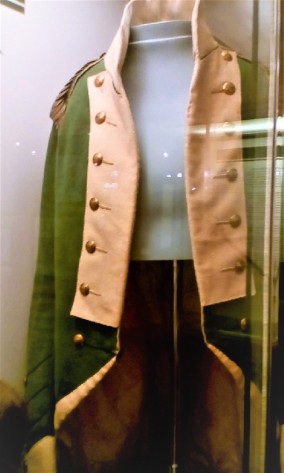
It’s a very distinctive colour (akin to the Norfolk Rangers I mentioned recently) and a pleasing design, which was of course entirely the point, it being important that the Northamptonshire Yeomanry looked impressive. A framed contemporary illustration accompanied the display, not very expertly reproduced below;
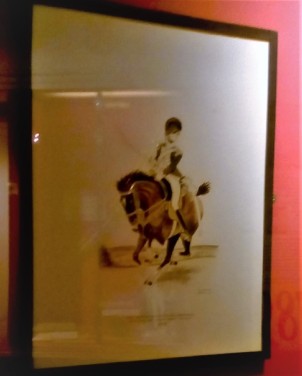
Already in my possession prior to the visit was a book on the Northamptonshire Yeomanry; “Yeomen of England” by Ken Tout. It is a warm and lively account of the regiment told by one of its former soldiers. In it, Mr Tout recounts how “one great attraction in [yeomanry] recruitment was the colourful, even gaudy design of the uniform of a troop or a regiment, and poets were already at work writing patriotic songs.” One such early song in 1794 praises the uniform of the newly formed Brackley Troop, part of the NY;
British Yeomen, valiant Yeomen, brave Yeomen for ever
Green coats faced with black and in each hat a feather
The waistcoats are buff and their trousers are leather
With broadswords and pistols and hearts without fear
Great Jove must be pleased when these Yeomen appear
They were obviously proud of their green uniforms, although I should have thought that ‘sabres’ would have a better substitute for the word ‘broadswords’ which would have been impractical to wield on a horse! There was no sign of the feather mentioned in the lyrics but a plume was commonly used with Tarleton helmets so it may have simply gone the way of the balding fur crest.
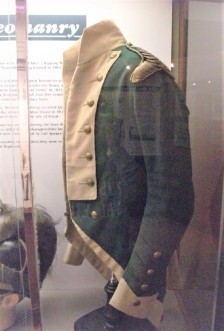
For the great smartness of their first green uniform, the regiment originally had to thank the affluent Earl Spencer whose influence with the King enabled him to secure the use of the King’s emblem, white horse of Hanover, one of only 4 regiments to be so honoured.

There was another uniform on display which I initially took to being an Northamptonshire Regiment infantry officer from the early half of the 19th century. I couldn’t spot an explanatory label and in my limited time in the museum I didn’t go back to confirm. However, Ken Tout’s book suggests that this uniform would have been similar to the mid-19th century Northamptonshire Yeomanry’s uniform. In 1844, the regiment escorted Queen Victoria and Prince Albert. Tout describes their dress;
“It was an opportunity for the yeomen to don their finery. immaculate scarlet tunics with dark blue facing. gold epaulettes and plentiful gold lace, and the riders’ heights enhanced by their bell-top shakos.”
On my hurried exit from the museum, I noticed that the final room of the collection housed a wonderful display of model soldiers from the local Northants Military Modelling Club. There were lots of terrific models on display, mostly I’d say 54mm scale, of the Northamptonshire Yeomanry through the ages both mounted and dismounted. One of these looked much like the above Ken Tout description of the Victorian escort, though my blurry phone camera ran out of storage and I ran out of time before I could attempt a photo. Prior to that, I did however discover a curious object stuck randomly underneath a table – it was a section of what appear to be bathroom tiles which had carefully been removed intact. On the times, illustrations of Northants yeomen through the ages on them! I presume some individual had hand-painted them. I think they’re terrific, one of those nice eccentric discoveries that make visiting a museum so enjoyable.

Now that’s my kind of bathroom design, (although possibly not my wife’s)! The ‘scarlet tunic’ mentioned in Tout’s book seems to be shown above (right on bottom row). Curse my blurry camera as the accompanying written descriptions which would have confirmed all aren’t readable. The green uniform seen earlier seems to be top right and the 1910-era version mounted in the middle. If we’re to assume they’re all Northamptonshire Yeomen, then it’s possible they also adopted an extravagant hussar style uniform, seen top left. If so, I assume this was approximately from some time between the 1850s up to 1873 (the year of temporary disbandment).
Tout’s excellent account also describes in detail the nature of the protective formation required by the Northamptonshire Yeomanry to guard the royal carriage from any threat. The fine and glittering sight of the scarlet-coated procession was commemorated in some spirited poetry by a local 17-year old girl, reproduced in the book:-
On Market Hill our great Yeomanry stood
To guard Queen Victoria to Weedon in the Wood
While through the High Street to Ket’ring she rides
With a thousand spectators arrayed on both sides
The Yeomanry in the Northamptonshire existed until the final troop (The Royal Kettering) was disbanded in 1873. As the Anglo-Boer War came to a conclusion, Northamptonshire, which had been without a Yeomanry regiment ever since, had a new regiment established, the Northamptonshire Imperial Yeomanry.
The Full Dress uniform was in the style of Dragoons and is described in “Yeomen of England” by Tout as being;
“…dark blue, with light blue facings and a white metal helmet with a light-blue and white plume. “

The uniform fitting that description was displayed in the collection (see above). It is a 1910 Full Dress tunic and Field Service cap belonging to the then commander of the regiment, Col. H Wickham. The PAOY website has some information on the Service Dress uniform of the Northamptonshire Yeomanry:
The first [Service Dress] uniform of the new regiment was of regulation drab, or khaki, with pale blue collar, cuffs and piping up back, sleeves and down the front of the jacket. Shoulder chains with brass lettering NIY. The Regimental badge, as worn on the collar, side-cap, peaked cap etc., was the “galloping white horse”: the badge used as the centre piece of Maltese Cross on the Shakos of the 1830-45 period.
The emblem of that Hanoverian horse could be seen clearly on the two later NY uniforms were also on display including this below. It is also prominent on the collar of this corporal of the NY. This tunic dates from 1902-1908 and was displayed alongside a pillbox cap. Note the shoulder chains on blue cloth backing.

Again, the Hanover horse appears – on the Full Dress helmet in a dramatic sunburst design…

…and finally on the front of the Field Service cap, below:
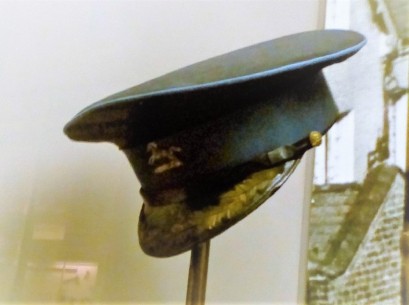
Most pleasing to me about this dragoon-style uniform and helmet was the attractive and unusual colour of the facings. Referred to by Tout and the PAOY website as being ‘light-blue’, this is described as being “Cornflower Blue” according to the “The Yeomanry Force at the 1911 Coronation” authors Robert J Smith and Ronald G Harris. Not only does it appear on the sleeves and collar of the tunic, but it can also be seen on both the cap and the helmet. The cap has this colour piped around the brim and also in a band around the middle. Other ranks apparently just had the band without the piping.
Two depictions of the Northamptonshire Yeomanry around the time of the coronation by R.J. Marrion and E.A. Campbell.
The helmet has a falling white over cornflower blue plume on a silver helmet, as can be seen below:

On the eight-pointed star, the garter inscription surrounding the Hanoverian horse says “Northamptonshire Imperial Yeomanry”, which was the name of the regiment on it’s 1902 reincarnation. In 1907, it became simply known as the “Northamptonshire Yeomanry” following the Haldane reforms.
The difference between the two examples of helmets relating to the officers and ranks seems remarkably slight. The plumes have been tied back to better reveal helmet details.

Below: the “Cornflower Blue” is evident on the collars and cuffs as well as the plumes:


Below: close up on the arrow pickers and chain on the officers pouch belt. Note the horse motif appears on the buttons as well.
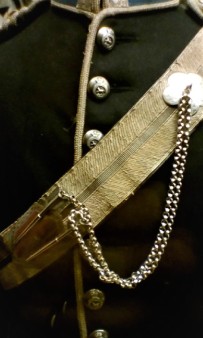
The most complete collection of NY uniforms came unexpectedly towards the end of the collection. I’ve mentioned in the final room was a sizeable collection of mostly 54mm scale models of the regiment in a wide variety of guises. Close up pictures weren’t really possible but I managed to take a couple of a figure I recognised as already being in my collection, ready to paint. I suppose it highly likely that I’ll try and reproduce the 1910 NY Full Dress using my own figure to match the one below!


The Militia:
I was surprised to learn recently that I have a personal connection with the Northamptonshire Militia going back to a relative who served sometime around the 1770s. This chap had the memorable surname Aldwincle (no, I don’t share this unusual surname) and he would have likely been compelled to serve in the force by ballot. This means of selection was not unsurprisingly often deeply unpopular with the mostly reluctant working class men who served in the Militia’s ranks, and so it may have been with Great, Great, Great Great Grandad Aldwincle.

It was particularly pleasing to see some items relating to the same period and regiment in which my ancestor served. The drum below was presented to the Northamptonshire Militia by Lord Viscount Althorp on the 1st September 1779. So, I feel a sense of connection as it is entirely feasible that my relative would have known and indeed heard this drum. He would also have quite probably having been in attendance during its presentation to the regiment on that day.

Another, larger, militia drum was also on display. This bass drum was presented to the regiment while it was on service in Dublin in 1854, probably taking on duties that other regular infantry would have been doing were they not off serving in the Crimean War. It’s a beautiful object, richly decorated and emblazoned with not only the name of the regiment but also of the name of the drum’s benefactor, the regiment’s own Lt-Colonel Lord Burghley.

With rich colonels such as Lord Burghley, one might expect militia officers to display some ostentation and these 1855 shoulder epaulettes provide some evidence of that. There’s a hunting horn symbol in the wreath, a sign of light infantry.

The Volunteer Corps:
The Northamptonshire Rifle Volunteers were represented by a grey uniform of the 1st Volunteer Battalion of the Northamptonshire Regiment. The name dates it from being after the 1881 Childers Reforms which merged the existing 48th and 58th line regiments into a single Northamptonshire Regiment, also attaching the local volunteer corps and militia as additional battalions.

With its grey uniform and red piping, and Home Service Pattern helmet, it looks much like the Cheshire Greys Rifle Volunteers that I modelled in 28mm scale last year.

Finally, it was interesting to see displayed a cymbal which had been presented in 1876 to the band of the 2nd Northamptonshire Rifle Volunteers, demonstrating that military bands could be as much a feature of the Rifle Volunteers as any other force in the British Army.

And very briefly, The Regulars!
Finally, although my greatest interest these days is on the volunteers, a very brief word on the Regulars. The Northamptonshire Regiment was formed out of the amalgamation of two pre-existing line regiments, the 48th and 58th regiments. It served in a number of theatres including New Zealand, a number of exhibits from which were displayed. There were some interesting watercolours and artworks around the walls, although the artists themselves seemed to be largely unknown.
Some uniforms of a type similar to those depicted above could be found around the museum.
They were lots of very interesting items on display, but some of my favourites included some extravagant 1832 epaulettes from an officer of the 58th Foot and a Pickelhaube and bugle, trophies from the Great War, Pickelhaube war booty always being a popular choice for many British regiments it seems.
Footnote:
Being a collection housed as a part of a wider museum, the Northamptonshire Regimental Collection inevitably suffers from the lack of focus that that entails. To enter into the collection, for example, I walked past a room inexplicably containing a large painting and am Egyptian sarcophagus! When compared to some other more dedicated military museums, the Northants collection felt a little lost and unloved.
At the time of writing, the Northamptonshire County Council has been in the news recently for being the first (of many?) to go effectively bankrupt. In such circumstances, with public services being pared down to a statutory minimum, culture and the arts could suffer greatly in favour of more immediately essential services. The fate of the Regimental Collection of Northampton in such circumstances remains to be seen.














Its always good to see a museum report- shame about the camera. What you have taken gives a good feel for the place though.
Cheers,
Pete.
LikeLiked by 1 person
It was a curious sort of place. The rest of the building strangely had a lot of almost empty rooms!
Thanks
Marvin
LikeLiked by 1 person
One our last trip to the UK in sept.18 we visited a number of military museum in England and Scotland and sadly the reported the same thing about the shortage of finances and much to my surprise at the Guards in London one old soldier said that things were that bleak that they might have to close up shop in the next couple of years . I have to say they were all pretty quite ,but that could have just been the time of year .
LikeLiked by 1 person
That’s worrying about the Guards museum. In the present climate, it could very much be a case of use it or lose it. Part of me thinks documenting some of these museum visits could actually be of some genuine value and I do wonder if some of them will still be around in the near future.
LikeLiked by 1 person
Personally that’s what sprang to mind when I came across your post in this regard as many a person has recorded something just for there own interest only to find it pop up later as important reference material .So yeah mate what you doing may well turn out quite important to future generations .
LikeLiked by 1 person